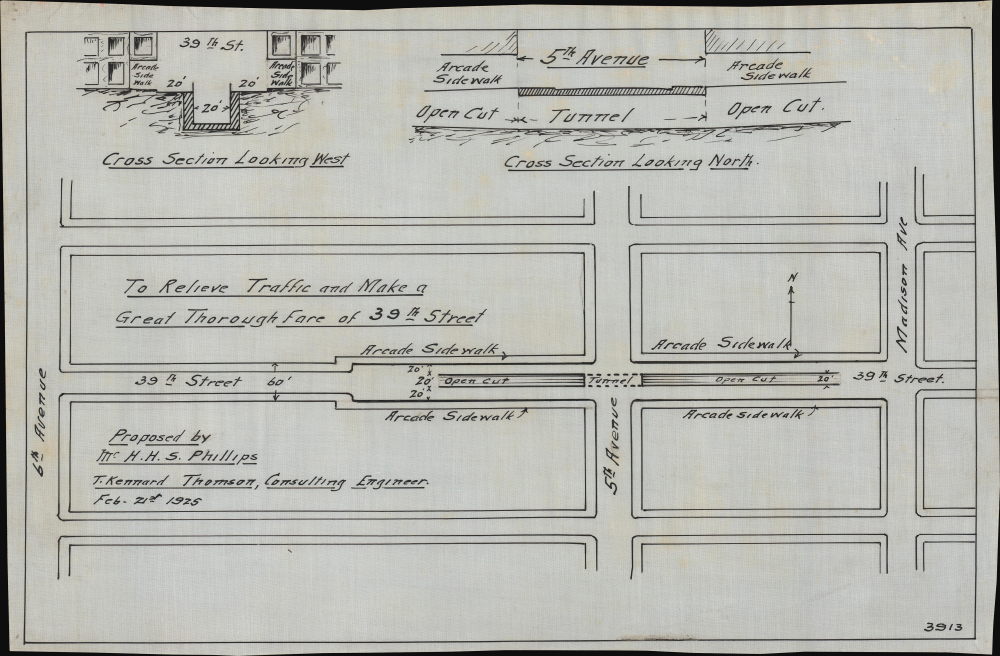1925 Kennard Thomson Plan for 39th St. Thoroughfare, New York City
39thStThoroughfare-thomson-1925
Title
1925 (dated) 11 x 17.25 in (27.94 x 43.815 cm) 1 : 1215
Description
A Closer Look
The two plans present an overhead view and cross-sectional drawings of the proposed open cut and tunnel beneath 5th Ave. The recessed areas would be dedicated to automobile traffic bypassing 5th Ave., while lanes on either side would be for traffic turning onto 5th Ave. (which ran in both directions at this time). The sidewalks would remain at their existing level but be modified to form pedestrian 'arcade sidewalks.'Thomson was an enthusiast of layering streets according to different functions - the present plans are a precursor to his much more ambitious plan in the late 1920s for a four-levelled distribution along major streets to divide automobile, train, and pedestrian traffic (see below). The open cut method was far less expensive than building subways or proper tunnels, and, although less elaborate than some of Thomson's other plans for New York, this scheme was motivated by the same desire to address major problems of urban congestion with bold and pragmatic solutions.
Kennard Thomson's Ambitious Urban Plans
In the early 20th century, Manhattan faced many of the same challenges as today - limited space, soaring real estate values, overpopulation, and gridlock traffic congestion. Kennard Thomson believed that engineering would come to the rescue. His solutions, including tiered avenues (as here, and more extensively in our NoMoreSubways-kennardthomson-1927) and massive landfills (NewManhattan-kennardthomson-1930), were novel and futuristic but in no way the crackpot fantasies of a maverick visionary. Kennard Thomson was a highly respected engineer, having pioneered innovations in pneumatic caissons, worked on countless major urban infrastructure projects, and spoke regularly at the American Society of Civil Engineers.Publication History and Census
These manuscript maps were drawn by H.H.S. Phillips (most likely the H.S. Phillips noted as 'the chief draughtsman of the main drainage section of the Department of Works, Toronto' in a 1915 issue of The Canadian Engineer) and Thomas Kennard Thomson between 1924 and 1925. Thomson's use of the title 'Consulting Engineer' suggests that these plans were meant to be presented to the city government. As manuscript works, they are entirely unique. These diagrams are jointly owned with Boston Rare Maps.Cartographer
Thomas Kennard Thomson (April 25, 1864 - July 1, 1952) was a New York City based civil engineer active in the first half of the 20th century. Thomson was born in Buffalo, New York, the son of William Alexander Thomson (1816 - 1878), founder and builder of the Canada Southern Railroad. He studied at the University of Toronto, graduating in 1886, then returning for a degree in Civil Engineering and a Doctorate of Science. He initially worked in Canada, first on the Canadian Pacific Railroad in the Rocky Mountains, then with the Dominion Bridge Company in Montreal. He moved to Brooklyn, New York, in 1889, initially taking a position with Pencoyd Bridge Company of Pennsylvania. He left this position within a year to attend the Paris Exhibition with the American Society of Civil Engineers. Thomson returned to a long and successful engineering career, working on hundreds of major projects, including more than 50 skyscrapers and 200 bridges. His New York City projects included the Singer Building (149 Broadway), the Commercial Cable Building (22-24 Broad Street Extension, demolished 1954), the Government Assay Building (40 Wall Street), the Mutual Life Building, and the Manhattan Municipal Building (1 Centre St). He was also one of five consulting engineers in charge of the New York Barge Canal (1814 - 1915) and developed a plan to build a dam in the whirlpool Rapids of the Niagara Falls. For a time, he served as chief engineer for Arthur Mullin, the foundation contractors behind some of Manhattan's early skyscrapers. He worked as a consulting engineer for the city until a week before his death of stroke, at age 88. Although his contributions to American engineering are innumerable, Thomson is best remembered today for proposing a massive extension of Manhattan into New York Harbor - although it never happened, the proposal received national media attention and is remarkably persistent, having been reproposed as recently as 2022. More by this mapmaker...






